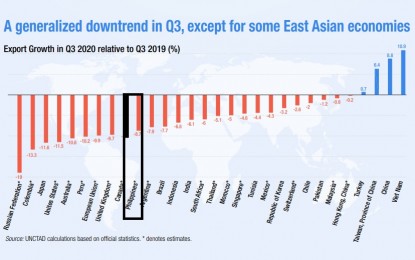
Screengrab from United Nations Conference on Trade and Development (UNCTAD) Global Trade Update October 2020.
MANILA – The United Nations Conference on Trade and Development (UNCTAD) sees Philippine exports to decline by 8.7 percent in the third quarter (Q3) of the year, easing from the double-digit contraction in the April to June period.
This is lower from the 29-percent decline in export revenues recorded in the second quarter (Q2) of the year based on the Philippine Statistics Authority (PSA) data.
Data from UNCTAD’s Global Trade Update for October shows that Philippine exports follow the global downtrend in outbound trade in Q3 2020 due to economic and social disruptions brought about by the coronavirus disease 2019 (Covid-19).
“Global trade continued to decline in Q3, about -- 4.5 percent year-on-year, although at a lower rate than in Q2, about -- 19 percent year-on-year,” the UNCTAD report published on October 21 said.
On the other hand, some East Asian economies have posted exports growth in Q3 2020 including Taiwan with 6.4-percent growth, China with 8.8-percent growth, and Vietnam with exports increasing by 10.9 percent.
“Overall, global trade is expected to fall by about 7 percent in 2020 under the assumption that the trend observed in Q3 continues into Q4 (fourth quarter),” UNCTAD said.
Trade of Covid-19 medical supplies peaked in May
UNCTAD reported that global trade for medical supplies related to Covid-19 peaked in May, which jumped by 74 percent.
“Nevertheless, the increase in the supply of Covid-19 related products has been largely to the benefit of wealthier countries. There is substantial evidence that middle- and low-income countries have been largely priced out from access to Covid-19 related products,” the report noted.
Aside from income, the report said that governments from poor or highly indebted countries have found themselves in a tight budgetary position to mobilize resources to increase healthcare expenditure, unlike the wealthiest economies. (PNA)
